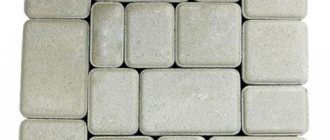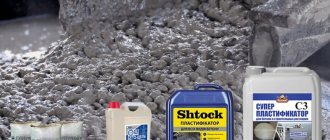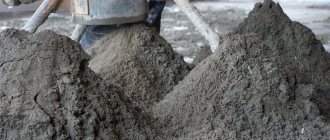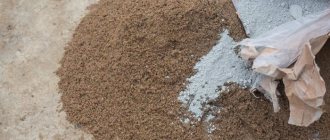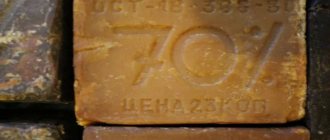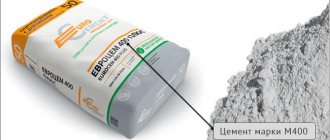Cement mortar is most often used in block or bricklaying, as well as for plastering, or as an adhesive for tiles or foam insulation. Now, for each of the listed types of work, there are special building mixtures, the composition of which was initially developed in such a way that the process of carrying out the work would be the most comfortable, and the result would be of high quality and durable. At the same time, it is well known that the independent production of some types of solutions in practice allows for significant savings, since factory-made ready-made mixtures are sold with a noticeable markup on the components from which they are made.
Which plasticizer is better for paving slabs, do it yourself, what is it for?
Cladding tiles are considered a popular building material, which is used to decorate garden areas, country cottages and other premises. Since the surface of the tile is subject to heavy loads, temperature fluctuations and precipitation, it must have an optimal degree of strength. It is achieved by adding special additives - plasticizers.
Glue Features
The components in the composition act as a plasticizer for tile adhesive; it is also called polyurethane with two components. The components of the glue are special hardeners and polyurethane resins. When mixing the components, an adhesive solution for deformable surfaces is obtained. Mix two-component adhesive using construction mixers or a drill, while wearing a specialized attachment for mixing construction materials.
If you read the instructions for the glue, it says that the glue dries within 30 minutes, but you shouldn’t rush and it’s better to give the mixture more time for 1-2 days, then the surface will be securely fixed and you can continue construction work.
Glue is a highly elastic material; it can be used to glue things that are held in place only by screws or nails. A gel-like plastic mass, this is what the structure of the mixture looks like.
Suitable for use in everyday life and on construction sites; it will hold old tiles that have a glazed structure.
Properties and advantages of plasticizer
In construction, this additive is used for a variety of purposes. For example:
- When making cement mortar with crushed stone or gravel. To ensure that the filler is distributed evenly, does not sag and does not form air valves, a plasticizer is added. Often it is played by ordinary water.
- To prevent delamination. After the solution dries, the product often has a fragile, porous surface on the reverse side. This is considered a sign of marriage. Such tiles will not last long and will crack.
Since paving slabs are constantly exposed to heavy loads, friction, pressure, shock, temperature changes, exposure to rain, snow, dirt, and often chemicals, special requirements are placed on its strength, and proportions are selected based on the requirements.
A plasticizer added to the solution during manufacturing will easily cope with all difficulties and make the tiles neater, smoother, more beautiful and stronger.
Physico-mechanical properties of mixtures
Elastic adhesive for laying tiles on drywall is one of the universal solutions. With its help, you can cover almost any surface with tiles of a wide variety of formats. As a rule, plastic mortars largely consist of quartz sand, modified additives, polymers, Portland cement, water-repellent components and plasticizers.
The specific composition of the mixtures mainly affects the technical performance of the solution, namely:
- Material density – at least 1400-1500 kg per m3;
- Bending strength – more than 3.5 MPa;
- Sliding index – no more than 0.5 mm;
- Solution consumption – no more than 1.3-2 kg per m2;
- Withstand high temperature changes - at least 70-100 cycles;
- Adhesion – at least 1-1.5 MPa.
Thanks to these characteristics, the mixture can be used for finishing entrances, building plinths, swimming pools, heated floors, bathrooms, foundations in industrial premises, etc.
Why are plasticizers needed?
When making a solution from a cement-sand mixture with your own hands, many people get a result in which the product crumbles.
The reason lies in the composition of the solution; it contains no adhesives. And, consequently, the strength of the product is unsatisfactory.
To eliminate this problem, you can add water. In this case, it will play the role of a plasticizer. After this, the mixture will be able to evenly fill the molds, forming an even and smooth surface.
But after the tiles dry, you can notice that the lower part of the tiles is thin and fragile. This occurs from the separation of components, the light ones rise and the heavy ones fall down. The result will be poor quality tiles, that is, defective tiles that will burst very quickly.
But even if the result is good, the tiles do not have cracks, the service life of such a material will still not be long. This is explained by the porosity of the product, and, consequently, water permeability. When exposed to frost, such tiles simply crumble.
Preparation is the Key to Success
The high cost of specialized dry mixes, compared to self-prepared sand-cement mortar, is due not only to manufacturer’s markups, but also to the quality guarantee of all ingredients in them. Therefore, in order to obtain a composition of plaster or masonry mortar that is similar in effectiveness, it is necessary to take into account that all its components must be of good quality. And first of all, you need to pay attention to the main ingredient - cement.
The choice of cement for preparing large quantities of mortar should be carried out very carefully by comparison. To do this, you need to purchase 3-4 test packs of cement from different manufacturers and from each make a small amount of the mixture with the same proportions. For each batch, compare the speed of setting and hardening. The choice should be made on the cement whose solution begins to set and completely hardens before the others.
Prev
Next
The next ingredient is sand, which can be bought here: stroyshheben.ru/pesok/. To make a good quality mixture, it is best to take a quarry one. But if you need a small amount of the mixture and you only have regular sand, mined in a field or taken near a river, then it can also be used. Only first such sand must be sifted through a construction sieve with a mesh size of 2x2 mm.
Which to choose?
To determine the choice of the appropriate type of glue, you need to know exactly the scope of its application. This is especially true for situations when tiles need to be laid in a bathroom or bathhouse. The material must have a sufficient level of water resistance.
When choosing, you should consider:
- specifics of the work, the tiles need to be laid indoors or outdoors;
- material of the surface on which the tiles need to be glued;
- humidity level and temperature indicator;
- type of tile.
When purchasing glue, you should not pay special attention to its price, since expensive compounds are not always of high quality and vice versa.
Compound
There are two types of plasticizer for paving stones: powder and solution. The first is intended for small-volume work and can be used at temperatures above -2°C. The second is suitable for all weather conditions.
The composition of most plasticizing impurities requires the presence of the following components:
- polymethylene naphthalene sulfonate – 80%;
- sodium sulfate and water - 10% each.
To understand which plasticizer for paving slabs is better to choose, you should determine the temperature conditions of its operation.
Dry plasticizer for concrete cannot be used in construction if the air temperature drops below -2°C Source sarhim.ru
Purposes of introducing plasticizers
To obtain a durable monolith, it is necessary to ensure uniform distribution of the cement mortar between the filler particles. The simplest way to achieve this is to increase the mass fraction of water.
On the one hand, this allows you to increase the fluidity of the mixture, on the other hand, excess moisture worsens the technical characteristics of concrete after hardening.
The optimal solution to this problem would be the use of plasticizers, the introduction of which into the mixture allows solving several problems:
with a decrease in the amount of water and cement, the strength increases by 15–20% ;
the risk of cracking is reduced;
the plasticity and fluidity of the concrete mixture increases;
there is a significant reduction in the reduction in concrete shrinkage during hardening;
frost and moisture resistance increases;
the adhesion of the mixture to the reinforcement improves;
the lifetime of the finished solution increases.
Recipes for solutions with homemade plasticizers
Having dealt with cement and sand - the main components of the mixture that determine its strength and durability - we can talk about independently preparing a solution that is in no way inferior in its characteristics to solutions made using modern plasticizers.
Additives for strength and ductility
To give the sand-cement mixture additional strength and ductility, the following additives are used:
- Styrene acrylic and vinyl acetate in the form of powders are added in an amount of no more than 10-12% of dry cement. Increases the flexibility, strength and moisture resistance of the mixture.
- CMC (Carboxymethylcellulose) in dry form 200-400 g per 10 liters of water.
- Liquid soap as a porogen - 70-150 ml per 10 liters of water. It is added at the end of the batch.
Here it is worth considering that the mixture turns out to be really convenient for installation, but is not suitable for concrete screed, as it generates a lot of dust and has reduced wear resistance to abrasion and trampling.
Glue recipe for insulating facades with foam plastic
Let's start with the recipe for glue for insulating the facade with polystyrene foam type PSB-S 25F (PPS-16F)
- 2.5 liters of cement
- A solution of 1.25 liters of water + 1.25 liters of PVA dispersion (not to be confused with PVA glue)
- 8 liters of river sand
- 100 g CMC (CMC glue)
If it is not possible to purchase PVA dispersion, then take the “MODIFIER” construction composition based on PVA. CMC glue is sold as wallpaper glue and increases the properties of the mixture for water retention, ductility and accelerates the development of strength.
Tile adhesive recipe
Recipe for making tile adhesive:
- Cement - 1 liter
- Water 0.75 liters
- PVA dispersion 0.25 liters
- Screened granite screening by consistency
Water with PVA dispersion is mixed until the solution is homogeneous and gradually poured into the cement, stirring constantly. Then, to achieve a consistency convenient for masonry, sifted granite screenings are added.
Gypsum plaster recipe
Gypsum plaster recipe:
- 10 kg alabaster
- 6 liters of water
- 250 grams (0.5 l) CMC glue
A solution of water with CMC is poured into dry alabaster at the rate of 400 grams of CMC per 10 liters of water.
To check the characteristics of self-made modified building mixtures, be sure to conduct preliminary tests before making and using them in large quantities. Make several samples with different homemade and store-bought compounds and let them dry for 4 weeks. The finished frozen sample is placed in water for 8-10 hours, after which it is placed in the freezer. The process should be repeated several times to ensure the strength of the self-prepared composition relative to the store-bought one.
Which to choose?
To determine the choice of the appropriate type of glue, you need to know exactly the scope of its application. This is especially true for situations when tiles need to be laid in a bathroom or bathhouse. The material must have a sufficient level of water resistance.
When choosing, you should consider:
- specifics of the work, the tiles need to be laid indoors or outdoors;
- material of the surface on which the tiles need to be glued;
- humidity level and temperature indicator;
- type of tile.
When purchasing glue, you should not pay special attention to its price, since expensive compounds are not always of high quality and vice versa.
Giving resin opposite properties
But sometimes rigidity acts as an undesirable factor, and, on the contrary, some flexibility of the product is required - while maintaining tensile or compressive strength. In such cases, specially produced industrial plasticizers are used, which are capable of imparting specified properties to the casting material after use.
In this material we will look at standard plasticizers, the use of which individually or in combination can give completely unexpected qualities to products made from resin: viscosity while maintaining strength, flexibility, even some elasticity when exposed to it in an attempt to push it. In addition, we will tell you about non-standard methods of imparting properties to epoxy castings inherent, for example, to special adhesives.
What is it made of?
Any paving stone consists of several components:
- cement;
- crushed stone;
- sand;
- plasticizers and other additives.
What kind of cement is needed?
The brand for the tiles should be selected in the range from 300 to 700. Strength indicators are needed because the paths will have to deal with loads, constant friction, temperature changes and adverse atmospheric conditions.
If we are talking about producing tiles at home, then use 400 grade. In any case, a private individual does not have industrial equipment that would allow the production of high-quality and luxury paving stones, so it is better to reinforce the tiles with a good brand of cement.
It is better to purchase cement from one batch and one manufacturer. The characteristics of cement may vary depending on the manufacturer, so this will affect the uneven quality of the finished tile.
Why are elastic mixtures needed?
Cladding with elastic glue occurs if the base is flexible or movable, for example, not a solid wall, but plywood, or the “shrinkage” of the house has not yet occurred, this applies to new buildings. Even if you buy a good cement-based tile adhesive, after a year or two the decoration will begin to crack or “slip” off the wall, and that’s because the adhesive base was not elastic enough.
The mixture must adapt to deformable substrates, so when choosing tile adhesive, pay attention to elastic properties .
We make plasticizer ourselves
At home, the plasticizer is made in the following sequence:
- Preparing the form (formwork). The walls of the container are lubricated with machine oil or generously moistened with water. This operation will make it easier to remove the casting.
- Sand and cement are poured into a concrete mixer. The composition is mixed until a homogeneous state is achieved (5-7 minutes).
- Pouring water into the pear. The liquid temperature should be within +15…+25 °C. The solution is mixed for 10-12 minutes.
- The addition of dyes, steel wool and other fillers designed to impart color, strength and elasticity to the product.
- Pour plasticizer diluted in a small volume of water into the container. Adding powder or bars of soap leads to the formation of lumps of additive.
- Stir for 10-15 minutes. Pouring the solution into the mold.
When pouring in stages, it is advisable to use a vibrator to tightly bond successively added layers.
CemStone
Highly effective complex additive for masonry and other building mortars.
More details
Due to these characteristics, cement compositions are used for brick, rubble, and stone masonry in multi-story construction, as well as at critical facilities.
In low-rise construction, various local binders, such as lime-slag, lime-ash and other cements, can be used to prepare masonry mortars, if they are produced in the area.
What can be replaced
What to replace it with? If we look at the reviews of people producing paving slabs, not everyone uses industrial plasticizers for these purposes. This component can be replaced using the following means:
- Foaming agent available at the fire department.
- Dishwashing liquid.
- Laundry soap, grated and diluted in water.
- Tile adhesive, PVA.
Consumer qualities of elastic adhesive
Adhesive solutions with maximum plasticity can be used for covering old glazed tiles.
If the elastic solution has the required degree of elasticity, it will “survive” the thermal expansion of the coating, vibrations and other types of deformations without any damage. That is, the greater the expected deformation load on the base, the higher the plasticity indicators of the solution should be. Elastic adhesive for installing tiles on DSP must have the following qualities:
- elasticity;
- moisture resistance;
- frost resistance;
- high adhesion;
- wear resistance;
- bending strength.
Adhesive solutions with maximum plasticity can even be used for cladding old glazed tiles. Such compositions are not at all afraid of extreme operating conditions, which is why they are so actively used for finishing “damp” rooms. The advantages and disadvantages of solutions can also be judged from consumer reviews:
Unis tile adhesive
- A year ago I decided to tile the floor, but first install an electric heating system. I used regular tile adhesive, which after three months began to crack at the seams. Six months later I had to re-floor the floor, but this time I used an elastic Ceresite mortar. So far nothing has come unglued anywhere;
- Elastic solutions in tubes are a very convenient thing! I tiled the apron in the kitchen, used Moment glue, and I quickly and very successfully completed the job. So far nothing has fallen off or become loose;
- I needed to spruce up a homemade partition in my living room. I decided to try not ordinary, but plastic glue. Of course, it costs a little more than cement, but there are no complaints at all about the adhesive ability of the mortar.
Limitations in use
Polymer adhesive is considered universal, but its use is not always possible, for example, for heated floors and places with constant heating, it is better not to use the mixture. This can lead to the glue starting to melt and the surface to collapse.
For ceramics and porcelain stoneware, you need to choose an adhesive with the appropriate marking; adhesive for tiles and wood flooring will not work.
Scope of application
Polymer adhesive is used for minor construction repairs and during construction; some types of mixtures are used for repairing automobile glass. When choosing a transparent solution, it can not only reliably glue the surface, but also not leave marks. It is a good camouflage for cracks and does not interfere with visibility when driving a car.
It is applied for:
- concrete having a cellular structure;
- chipboard;
- cement particle boards;
- drywall;
- plywood;
- aerated concrete;
- old tiles;
- concrete screed;
- wood;
- porcelain stoneware;
- marble and glass mosaics;
- acid-resistant and clinker tile products.
Laying principles
How to lay tiles with elastic adhesive on wood plywood.
- Wooden layers with a thickness of 25 mm or more must first be laid on the beam and secured with self-tapping screws. We place the beams closer to each other, a distance of approximately 50 cm.
- Dust and other contaminants are removed from the surface, then a primer is applied and left to dry.
- Apply the adhesive base on top of the floor.
- Then apply the mixture to the back of the tile with a notched trowel; no need to use a thick layer.
- Next, the tiles are laid on the surface; if the tiles have a pattern, immediately prepare the order in which they go.
- We wait for the glue to dry completely and start grouting; special mixtures are sold for this.
- After the repair work is completed and the grout has dried, wet cleaning is carried out.
